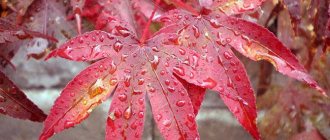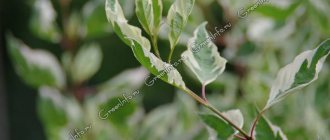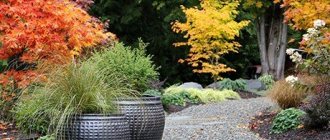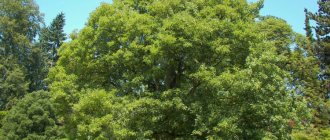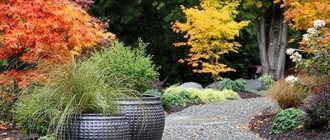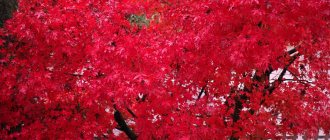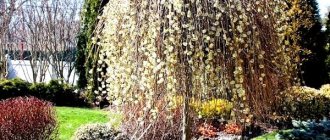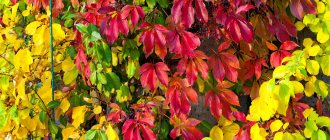Maple is extremely popular because of its appearance, especially in the fall, when its leaves turn fiery red, orange or yellow. This genus consists of more than 150 species. It can be presented in the form of a tree or shrub. In our article we will tell you about the most popular types and varieties of maple, give their brief characteristics and some tips on growing.
Norway maple or sycamore (Acer platanoides)
It is one of the most popular types of maple and is very often found in parks and forests. It is characterized by rapid growth rates, which makes it possible to create green fences and decorate parks from it in a relatively short period of time. In early spring, resinous buds form on the branches, which after some time turn into leaves. The leaves have a five-lobed configuration, are large in size, each blade ends with a sharp end. Depending on the season of the year, the leaves can be light green, green, yellow, orange-red, red or brown. The leaf surface is permeated with clearly defined veins. The tree can grow more than 30 m in height.
Young shoots are covered with smooth red-brown bark. Old shoots are distinguished by bark with cracks and a brownish-grayish color. The crown is spreading and dense. During flowering, the trees are covered with green or yellow small flowers that form shield-shaped inflorescences. Flowering begins in April-May. The flowers bloom before the leaves are formed, so during flowering the tree looks very beautiful and stands out from other trees. Flowers also release a pleasant sour-honey aroma that attracts insects. There are different types of flowers on the same tree. These plants are considered honey-bearing; each flower contains a large amount of nectar. Maple honey is light yellow in color, has a pleasant aroma and exquisite taste. At the end of flowering, seeds are formed, which are attached to two-lobed wings. After the seeds ripen, they tear off the branch and are carried by the wind over large areas. After overwintering under a layer of foliage, the seeds germinate in the spring and cover the soil with young shoots.
Benefit
Red maple and other types of similar trees are not only beautiful, they are also useful. Maple seeds, sap and other parts of the tree contain a large number of substances beneficial to the human body. From maple fruits you can prepare decoctions and infusions used to treat various diseases. Maple is especially useful in densely populated cities, as it helps neutralize benzene vapors and heavy metals that trap maple leaves.
Ash-leaved or American maple (Acer negundo)
This tree is considered one of the most unpretentious and hardy of its kind, therefore it is often used for planting in large cities. The plant is also characterized by increased resistance to dust and gas, and has enhanced regeneration properties. This maple grows in height up to 15-20 m, has a trunk circumference of about 40-60 cm. The crown has slightly drooping shoots, develops unevenly, the trunk is slightly curved, covered with gray bark with small grooves. The leaves are arranged oppositely on long petioles, have 3-7 lobes, a length of 15-17 cm, an odd-pinnate configuration and a light green color.
The culture blooms with dioecious flowers: male flowers open earlier than female ones. The aroma of flowers attracts bees, which take nectar from them for honey. Flowering occurs in late spring early summer and lasts for 2 weeks. The flowers are small green in color and bloom along with the leaves. At the end of flowering, fruits are formed, consisting of a seed and an impeller. Full ripening of the fruits occurs in mid-autumn, but they continue to hang on the shoots until spring. More than 500,000 lionfish form on one tree. The average lifespan of a tree is 80-100 years in the wild; in growing conditions under unfavorable factors it is about 30 years.
Field, plain or Neklen maple (Acer campestre)
This type of maple is used for park plantings due to its medium growth. In addition, it is very undemanding to growing conditions and does well in urban conditions of gas pollution and dust. The tree grows up to 12-20 m in height and is characterized by a broadly conical crown consisting of bright green five-lobed leaves. After all the leaves on the tree have blossomed, flowering begins. Flowers cover the crown and give the tree a very decorative appearance. The trunk is covered with light brown bark with light white stripes. This species is slightly frost-resistant and prefers to be grown in warm climates. Bonsai is often made from this species, since the tree tolerates cutting and shaping well. The plant has stable immunity against diseases and damage from insect pests. The root system is very powerful and branched, thanks to which the tree tolerates drought and soil compaction well.
This species has several varieties that differ in popularity:
- Field maple Elisriysk. A tree of this variety grows up to 8 m in height. It has a dense crown of a spherical configuration. The crown circumference is about 5 m. The shoots are covered with large five-lobed leaves. The leaves bloom in mid-spring and are reddish in color. When grown in the sun, they change color to yellow. When grown in the shade - green. During flowering, small yellow-green flowers bloom, collected in corymbose inflorescences. At the end of flowering, two-winged seeds are formed.
- Field maple Red Shine. This tree is short in stature, about 5 m. Its crown and spreading trunk are covered with gray bark. The leaves are large, multi-lobed, and have a red-purple color. It blooms with yellow or green flowers collected in medium-sized inflorescences.
- Field maple albovariegatum. This variety is characterized by trees no more than 5 m high. It is used to create hedges. It has a strong trunk and a wide branched crown, which is formed from the bottom of the trunk. The bark is silvery in color and covered with small cracks. The large leaves are light green in color, changing to yellow in the fall.
- Field maple Queen Elizabeth. This variety is characterized by fast growth rates and vertically growing shoots that form a narrow pyramidal crown configuration. The crown circumference reaches 10 m, the height of the tree is 80 m. Due to the shape of the crown, this variety is often used to decorate alleys and garden parks. In mid-spring, the shoots are covered with large leaves that are light green in color. The plant feels good when grown in shaded areas, but cannot grow in marshy soil. It also tolerates gas and dust in the atmosphere well, which is why it is often grown in large cities.
- Red field maple. It has a slow growth rate, grows up to 8 m in height. It has a decorative branched crown. The tree got its name due to the fact that its young branches are dark red in color. During flowering, the entire crown is decorated with small green-yellow flowers that form racemose inflorescences. At the end of flowering, lionfish about 3 cm long are formed, which consist of one large seed. The palmate leaves are olive green in color. The root system is branched and located in the upper layers of the soil. Reproduction occurs by root shoots or by seeds.
- Field maple spherical. This variety got its name due to the spherical shape of the crown. The tree is characterized by slow growth and grows to a height of no more than 5 m. Young leaves have a red-orange color, changing to golden yellow in the sun. The flowers are small yellow-green, forming paniculate inflorescences. Lionfish fruits. The root is highly branched and grows in the upper layers of the soil. The crop is propagated by root shoots, seeds or grafting.
Maple in landscape design
In addition to landscaping streets and squares near the house, the ash-leaved flamingo can be used in several types of garden decorations.
Mixborder
- compositions with his participation can serve as the border of the site and divide it into zones as a kind of hedge;
- a maple planted in the middle row of a garden complex looks good in combination with shrubs and flowers, shading the front low-growing plants;
- in shady areas where there is not enough light for flowers, it can replace them, especially if shade-tolerant hostas, lungwort, and fern are placed next to it.
Open mixborder
The decorative maple here is located as if on an island and serves as its main attraction. Surrounded on all sides by lawn or outlined by other low vegetation, it proudly presents its splendor to everyone. The naturalness of the design is achieved by moving the tree away from the center of the composition.
Single landing
A flower garden located around a separate tree looks very advantageous and colorful. Petunias, begonias, pansies, and lobularia go well with it. It’s easy to fill a tired flowerbed with decorative wood chips, pebbles or stones.
White and pink compositions
The color of maple leaves can serve as the basis for creating a white and pink corner of the garden when selecting plants of similar shades next to it. Occasionally contrasting “spots” found in this area will add a little intrigue and courage to the strict and delicate composition.
Narrow-crowned sycamore maple (Pseudoplatanus 'Erectum')
This species was bred in Holland in 1935. Its representatives grow up to 25 m in height, however, the crown is only 8 meters. Young trees have a columnar crown configuration, while older trees have an oval shape. The leaves are large, leaf length is about 30 cm, attached to short thick petioles. The flowers are formed in umbellate inflorescences and are yellow-green in color. Trees prefer to be grown in shaded areas, in loose, fertile soil.
Autumn maple leaves
In the fall, maple leaves turn yellow and red-orange colors interspersed with the remaining summer greens. Moreover, each leaf vein can have its own color. One small leaf can have about 6 colors.
The maple leaf is incredibly beautiful in autumn. It can be yellow, red, orange. There are motley and spotted ones. During the period when the fantastically beautiful maple leaves fall, it becomes unusually fabulous in the forests and parks.
And how beautiful are the golden landscapes during the bright autumn with maple forests!
Many artists and photographers add beautiful works to their collections at this time of year: still lifes, landscapes.
River maple (Acer ginnala)
Trees of this species are about 10 m high. The stems grow vertically, have a thin shape, the trunk is short, covered with light brown thin bark. The bark of mature trees does not develop deep cracks. The leaves are simple in shape, green in color, and have a glossy shine. By autumn they change their color to red or yellow-orange. Flowering occurs simultaneously with the formation of leaves. The flowers are green-yellow in color and form racemose inflorescences. At the end of flowering, winged fruits are formed, which are red in color. This variety is characterized by high frost resistance, drought resistance and wind resistance. Propagated by seeds.
Diseases and pests, how to deal with them
Of the entire list of diseases, the following are dangerous for maple:
- coral spotting;
- powdery mildew;
- brown rot.
To avoid diseases, trees are periodically treated with special products. For example, affected and dead branches need to be cut off, and garden varnish and medicinal putty should be applied to the removal sites.
Pests for maple are:
- Mealybug. The insect does not attack the tree if the trunk and leaves are treated with nitrafen in early March.
- Whitefly. When insect larvae appear, they can be removed using ammophos. Infected leaves and branches should be burned.
- Leaf weevil. You can get rid of it by treating it with chlorophos.
- Aphid. Leads to leaf curl and death. You can avoid aphid attacks thanks to dimethoate. Treatment is carried out by spraying.
Timely prevention will protect the tree from diseases and insect attacks.
Sycamore maple (Pseudoplatanus 'Negenia)
This is a fast-growing type of maple, which reaches a height of about 30 m. The diameter of the crown does not exceed 12 m. The crown has a wide pyramidal shape, consists of large dark green leaves covered with clearly defined veins. The leaves are held on short red petioles. The flowers are green or yellow, fragrant, and contain a large amount of nectar. Lionfish fruits. Sycamore maple is widely used for landscaping streets and city parks; it can grow on any type of soil and is a wind-resistant, frost-resistant plant. Propagated by seeds or vegetatively.
Using maple
- Maple has not found its own use in official medicine, but folk healers use different parts of the plant to prepare medicinal compositions. Buds, leaves, bark, flowers and maple sap are used as medicinal raw materials.
- This tree has medicinal properties due to the content of tannins, alkaloids, sugars, carbohydrates, vitamins and flavonoids. Medicines made from maple have diuretic and choleretic effects.
- Infusions and decoctions of maple leaves and bark are used to fight various infections, boost immunity and improve the condition of hair and skin.
- Maple is also famous as a wonderful honey plant. Its honey production is quite high and amounts to 150-200 kg per 1 hectare of planting.
- Maple wood is also used in the furniture industry. It is used to create parquet, skis, musical instruments, cladding panels and chess pieces. Its use has become popular since ancient times.
- Maple is specially grown for its wood because it is highly processed. This is the most suitable material for creating railings and stairs.
Purple-leaved sycamore maple (Psevdoplatanus 'Atropurpureum')
A fast-growing deciduous tree about 30 m high, with a 15-meter wide conical crown. The leaves are five-lobed, each lobe has a sharp end. When blooming, the leaves have a brownish-red color, which changes to dark green. The back side of the leaf is covered with thick red hair. At the end of flowering, winged fruits of a dark red color are formed. The tree can be grown in urban gas and pollution conditions. It is frost-resistant and likes to be grown in open, sunny places.
Garden design
To decorate a garden plot with maple trees, any variety of this tree is suitable. Maple feels great in the city - in conditions of increased gas pollution. It is this quality that is the reason that many gardeners choose Norway maple for landscape design.
In addition, maple leaves have different colors at different times of the year.
To give the site elegance, it is necessary to plant flowers and shrubs next to the maple trees. The maple tree looks elegant surrounded by coniferous trees. Norway maple is a unique tree that will decorate any garden plot.
Sycamore maple (Pseudoplatanus 'Rotterdam')
This species was bred in Rotterdam and is a rather valuable plant species. The tree is large, has a cone-shaped branched crown, which takes on the shape of an ellipse at the age of 5-7 years. In winter, the trunk is covered with green bark. The leaves have the same length and width, which is 10-13 cm. The size of the leaf differs depending on where it grows. The trunk leaves are smaller in size. The leaf blade is dark green and has many bright veins. These trees are slightly frost-resistant; they like to be grown in semi-shaded places and in the sun.
Planting and care
Young trees develop well in fertile soils. However, if the groundwater does not flow deeply, then crushed stone drainage is placed at the bottom of the planting hole.
When planting, be sure to maintain a distance of at least two meters. When planting a maple hedge, maintain a distance of 2 meters.
Young plantings are provided with good watering. However, what the plant will be like depends not only on the quality of the soil and care. It also depends on the quality of the planting material. To grow a decorative black maple like in the photo, you need to put a lot of effort into finding a good seedling. The black variety is not cheap, so the low price of such plants should be alarming.
When purchasing maple seedlings, it is important to consider the time of planting. It is best to plant maple trees in late September or early October. During planting, the leaves should be slightly wilted and there should be no damage or defects on the roots.
The maple is planted in a planting hole so that the root collar is located flush with the soil surface. After planting, the plant is immediately watered.
The tree responds gratefully to good care. It is recommended to feed it at least three times a season with complex mineral fertilizers. It is recommended to shade young trees in the first year of life in a new location from the scorching sun. Also, young trees need abundant watering: during drought, it is recommended to water the maple 1-2 times a week (depending on the type of soil). There should be enough water so that it can saturate the soil to a depth of 1 meter or more.
The soil under the seedling must be loosened and weeds removed. Black species should not be pruned, unless, of course, you plan to create a unique landscape composition. But sanitary pruning must be carried out once a year, removing all frozen, dry branches during the procedure.
Acer divergens Pax
This type of maple is native to Türkiye and Armenia, where it can be seen on dry slopes. The height of such a tree does not exceed 4 m, the crown circumference is no more than a meter. Refers to slow-growing deciduous trees, the growing season of which begins in April and ends in November. Flowering occurs in May and lasts for 7-10 days. Fruits are formed on trees that are 10 years old. This species is very frost-resistant, able to tolerate frosts of more than 25 degrees.
Where does Norway maple grow?
Norway maple mainly grows in the European and Western Asian parts of the globe. In northern latitudes it predominates in Finland, Canada, Scandinavia and Karelia.
- In a mixed forest, maple can grow in small groups or singly.
- Groups of this tree can most often be found on slopes near water bodies or on the edges of forests.
- Maple is a cold-loving plant.
For normal life, it needs a temperature no higher than five degrees; it tolerates frosts up to forty degrees. Maple loves well-moistened soil with a high nitrogen content. The tree does not grow well on clay and sandy soils.
Japanese maple (Acer japonicum Aconitifolium)
Representatives of this species are distinguished by trees that grow no more than 5 m in height. The shoots are covered with decorative leaves of light green color up to 15 cm long. The crown has a cone-shaped configuration. Flowering occurs at the end of April, the tree blooms with green-yellow flowers collected in racemes. The root is widely branched and grows in the upper layers of the earth, so the plant reacts painfully to swampy and waterlogged soils. Likes to be grown in open sunny places in fertile, loose soil. Does not tolerate pruning well.
Coralbark maple (Acer palmatum 'Sangokaku')
This type of maple is represented by a shrubby plant growing in height up to 6 m. The variety was named due to the fact that young shoots have a bright coral color, the intensity of which intensifies in winter. The leaves are light green with a pink tint. The leaf blade is grayish, has a red edge along the edge. In autumn the leaves change color to bright yellow. It blooms with greenish-yellow flowers that form small inflorescences. The inflorescences densely cover the crown and give the tree a decorative appearance. Due to the shallow root system, the tree needs regular watering and reacts painfully to waterlogging and stagnation of water in the soil. It is also not recommended to reforge the area near the trunk with a bayonet shovel, so as not to damage the roots.
Harm of maple and contraindications
If you use decoctions and tinctures based on maple raw materials in moderation, then you don’t have to be afraid of causing harm to the body. Considering that maple contains a large number of alkaloids, it is not recommended for women in late pregnancy to take it. This is due to the fact that alkaloids can cause involuntary contractions of the uterus, which will lead to bleeding or termination of pregnancy.
It is also necessary to take into account personal intolerance to some components, which may result in an allergic reaction and harm to the body.
Important! Fallen maple leaves have healing properties to the same extent as green leaves on the tree.
Yellow ash maple (Acer negundo 'Odessanum')
This tree has an average growth rate and grows to a height of about 6-7 m. It is characterized by the presence of fleecy white shoots. The leaves have a yellowish color and a shiny surface, forming a spherical and very dense crown. This variety is most often propagated by grafting. Flowers form in umbellate inflorescences that densely cover the stems. Trees are sensitive to soil compaction due to their shallow root system. Due to the strong branching of the root shoots, the plant tolerates strong winds well. It likes to be grown in open sunny places, but also does well in partial shade.
Nutritional value and chemical composition
The beneficial properties of maple are associated with its special chemical composition. Thanks to its many useful components, maple is widely used in cooking, folk medicine and cosmetology.
The following components of the plant are distinguished:
- organic acids;
- potassium;
- magnesium;
- calcium;
- silicon;
- saponins;
- alkaloids;
- tannins;
- carotenoids;
- rubber;
- resin;
- vitamin C and E;
- fatty acid.
Maple Semenov (Acer semenоvii)
The homeland of this species is considered to be Central Asia and Central Afghanistan. The tree can be presented in the form of a bush. It has an average growth rate and does not exceed a height of 6 m. The crown is formed in a spherical configuration and consists of grayish shoots covered with smooth bark. Mature trees have wrinkled bark. The leaves have a fleshy texture. The upper side of the leaf is grayish-green, the back side is light green. It blooms with yellowish flowers collected in medium-sized inflorescences. At the end of flowering, winged fruits are formed, about 3 cm long. The tree is a frost- and wind-resistant plant and can be grown in semi-shaded places.
Golden variegated ash maple (Acer negundo 'Aureo-variegatum')
A representative of this species can grow up to 7 m in height and have a crown circumference of up to 5 m. The crown is branched and hemispherical. The tree is a fast-growing one. Young leaves are distinguished by a pink color, which changes to light green, covered with yellowish spots. The leaves are decorated with a golden border along the edge. Flowering begins in mid-spring with yellow flowers hanging in semi-umbrella-like inflorescences. It is a very shade-tolerant plant that can grow in almost any soil. Tolerates frosts and strong winds well. Propagated by grafting and seeds.
Folk remedies
An infusion is prepared from fresh maple leaves. For it you will need to grind the leaves, then pour a glass of boiling water over a spoonful of the raw material and let it brew for thirty minutes. The resulting tincture is taken three times a day, dividing the resulting volume into equal parts.
You can prepare an alcohol maple tincture. To prepare it, take a container into which maple leaves are placed. Then they are filled to the brim with vodka. The composition is infused for two weeks, after which it is filtered. Take twenty drops before meals.
To treat oral pathology, take a spoonful of raw materials and pour in 1.5 cups of boiling water. The resulting mixture is simmered over low heat for half an hour. The finished product is allowed to cool to room temperature. It is used as a mouth rinse three times a day.
Silver maple (Acer saccharinum)
This species is one of the largest maple trees, the height of which can exceed 40 m. The crown is spreading and very wide, consisting of silvery, large, five-lobed leaves. The trunk is covered with light gray bark with small grooves. Trees prefer to grow in moist soils with plenty of sunlight. It has a superficial, widely branched root system. Propagated by winged seeds.
Variegated ash maple (Acer negundo 'Flamingo')
This species can be presented either as a bush or a small tree. The height of the tree can be about 7 m. The crown has a circumference of 4-6 m and consists of silver leaves with a pink or marble pattern. The leaves are attached to pink-green or pink petioles. The bark of young shoots has a bluish shiny coating. The tree is drought-resistant and likes to be grown in semi-shaded places.
Join our Facebook group
Juice
One of the most useful products obtained from maple is sap. The first mention of it occurs in the sixteenth century.
The beneficial properties of black maple lie in the benefits of the juice. It contains many vitamins, micro- and macroelements. The juice is 90% water. The juice contains many antioxidant compounds that are useful in the fight against cancer and pathologies of the cardiovascular system.
Maple sap contains little sugar, fructose, and glucose, which is why it is recommended for people suffering from diabetes and obesity.
Since ancient times, people have used not only maple sap, but also its leaves. Decoctions are prepared from them and are used to treat diseases of the nasopharynx and skin pathologies. The effectiveness of the product is due to the antimicrobial effect of the resulting product.
Clen is considered a good antidepressant. Drinking juice helps reduce aggression, overcome stress, and restore energy. In some areas of Germany it is used as a means to increase potency.
There are no contraindications for taking juice.
